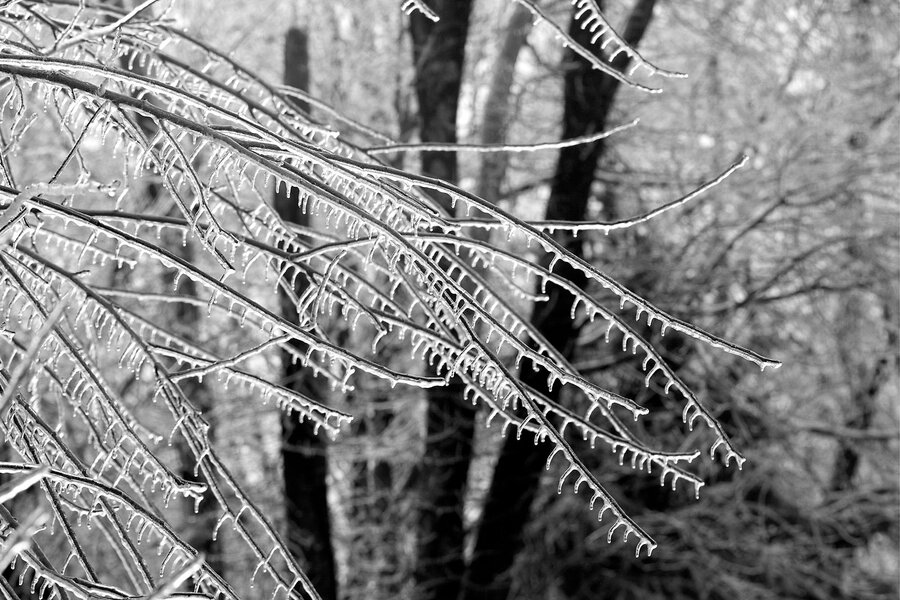The unexpected bounty of winter gardening
Loading...
The other day I was up in my apple tree, pruning away under a slate-gray sky with more snow in the forecast. A neighbor slowly drove by, stopped, examined me, and shook her head with a hint of disapproval before continuing on, as if to say, “Doesn’t that man know this is winter? Doesn’t he know this is Maine?”
Well, yes, I do. But that’s the allure of winter gardening. You see, it’s easy to tend a garden in good times, when things are thriving, blooming, and setting fruit. It’s easy to be outside under clear skies, with warm breezes and an affirming sun. And when the garden has gone to sleep, it’s easy to say, “There. I’ll see you in the spring.”
The thing is, once trees and shrubs have lost their leaves, and the stalks of perennials are mere shadows of their former, vibrant selves, the garden becomes transparent, revealing new work that needs to be done.
Winter is an overlooked season, but it need not be.
Take my apple tree, for example. It boasts a dense green canopy in spring and summer, hanging onto its leaves well into the fall. But once those leaves disappear, the tree reveals branches studded with upright shoots called “water sprouts.” In short, it looks like a teenager in bad need of a haircut. And so I take my apple ladder and make my ascent. It’s cold, and there’s snow on the ground, but my work warms me. I prune away, clambering among the more robust branches, which reach out like welcoming arms to receive me, as if appreciative of my efforts in a season when so much goes unloved.
There’s more work in the offing. The thin racemes that produced the hosta’s pink flowers need removing, the high-bush blueberries have too many canes, the honeysuckle has grown leggy, and then there’s the rhododendron. Let me spend a moment here.
A rhododendron is nothing if not constant. Almost indestructible, it’s easy to take for granted because it never loses its leaves, leading one to believe it is something of an aristocrat that doesn’t need attention. It therefore tends to be overlooked among the garden’s inhabitants. But now, in winter, precisely because it stands out among its bereft companion plants, its pruning needs become conspicuous. Snip-snip here, snip-snip there. My reward will be a jubilant flowering forth in the spring. But in this moment, there is more: I bring a cut branch to my nose and inhale a spicy pungency, as if the plant is delivering the message, “It is winter, but inside me there is life. Promise. Hope.”
As I work away in the cold, under these heavy skies, my mind wanders to my relationships, both friendly and familial. It’s easy to pay attention to others when everything seems to be going well. (Who doesn’t celebrate a child who is healthy, affectionate, and getting good grades in school?)
But winter comes to everyone on occasion, as life seems to have a bottomless pit of challenges. The path of least resistance is to back off rather than to reach out.
Thus it was with one of my freshman students this semester. I gave him well-deserved praise as he logged stellar grades and was an ace in class participation. And then one day, I noticed an uncharacteristic grayness about the lad. It would have been easy to keep my distance and allow his mood to run its course.
But he was a student in my classroom garden, and when he lingered after class, rather sad-faced, I decided to ask him to sit with me. Then the dam broke. He told me he was feeling overwhelmed in school.
We sat, I listened, and I realized that this was a bright, capable student who had simply taken on too much; his course load was overgrown and in want of weeding. I could also see that this young man was the product of some very good parenting. In short, his roots were solidly in the ground, giving him great potential to thrive.
And so I handled him with the same attention I would give the arborvitae (Thuja occidentalis) that grows in my dooryard: I helped him to prune away the one course too many he was carrying, and I mulched his concerns with my observation that he was going to be a very successful student.
It will be something to behold when this young man eventually blooms.







